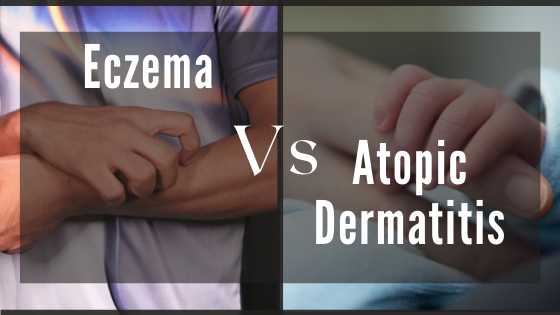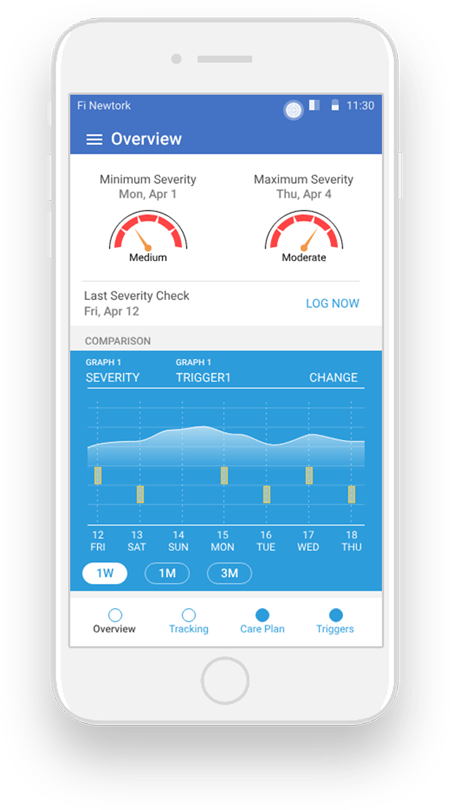Eczema vs. Atopic Dermatitis

Table of contents
- Eczema vs. Atopic Dermatitis: What is the difference?
- What are the different types of eczema?
- What is atopic dermatitis and how does it differ from other types of eczemas?
- What are the features that are common to all types of eczemas including atopic dermatitis?
- What are the differences between other types of eczemas and atopic dermatitis?
- Summary
Eczema vs. Atopic Dermatitis: What is the difference?
Eczema is a common chronic skin condition. Eczema is the name given for a group of skin conditions that cause your skin to become inflamed, red and itchy. The lighter skin tones usually become red, while darker skin tones become brown, gray or ashen. Eczema is not a contagious skin disease and you cannot ‘catch it’ from someone. However, the exact cause is unknown, but there is a combination of genes and environmental factors that play a role. When an allergen or an irritant which may be from outside (extrinsic) or even inside (intrinsic) your body activates your immune system so that inflammation can set in. The symptoms occur because of this inflammation and it is common to almost all the different types of eczema.
What are the different types of eczema?
There are 7 different types of eczema. They are;
- Atopic dermatitis
- Seborrheic dermatitis
- Contact dermatitis
- Stasis dermatitis (varicose eczema)
- Nummular eczema (discoid eczema)
- Dyshidrotic eczema (pompolyx)
- Neurodermatitis (lichen simplex chronicus)
The above different types of eczema has its own effects on the skin and should be treated accordingly
Although atopic dermatitis is commonly referred to as eczema, it is only a type of eczema. This is probably because atopic dermatitis is the commonest form of eczema. It is the reason why many people simply refers to it as eczema. Research suggests that atopic dermatitis affect 15- 20% of children and 1-3% of adults worldwide.
It is possible to get more than one type of eczema at the same time. However, each type of eczema has its own triggers and the treatment methods can be different. Therefore, it is important to consult a dermatologist who specializes in eczema in order to diagnose the exact type or different types of eczema you have. He or she will be able to formulate a management plan accordingly so that you will be able to prevent future flare ups.
We should be aware about these different types of eczema and take precautions accordingly.
Track and Manage your Eczema treatment using a comprehensive Eczema App
Download Eczemaless now
What is atopic dermatitis and how does it differ from other types of eczemas?
Atopic dermatitis is the commonest type of eczema which makes your skin dry, itchy and cracked. It is commonly seen in children and it develops often before their first birthday. However, atopic dermatitis can develop in adults for the first time.
The difference is that other types of eczemas are commonly seen in adults than in children.
Just like other types of eczemas atopic dermatitis is a chronic (long term) skin condition. In some children it can clear completely or improve significantly as they grow older. This type of improvement with age is seen in atopic dermatitis and not usually in other types of eczemas.
The symptoms of atopic dermatitis may vary. Some will have dry, itchy skin in small patches while others have wide spread inflamed skin throughout their bodies. Atopic dermatitis commonly affects hands, insides of elbows and backs of knees. Although it can affect any part of your body. Face and scalp are affected especially in younger children. Atopic dermatitis may come as flare ups. These are periods when symptoms become more severe.
Like other types of eczemas, atopic dermatitis does not have a clear or an exact cause. ‘Atopic’ means sensitivity to various allergens. Therefore, atopic dermatitis occurs often in people who are prone to get allergies. Atopy runs in families and can associate with other allergic conditions like hay fever and asthma.
Certain triggers like soap, detergents, hot and humid weather and stress can lead to symptoms or flares. Especially in young children even food allergies may play a role.
Here is a brief overview of other types of eczemas.
- Seborrheic dermatitis – also known as seborrheic eczema. It is a type of eczema where red and scaly patches develop on your eye brows, sides of the nose, scalp and ears. Seborrheic dermatitis commonly affects the hair growing areas and areas where oils (sebum) are secreted. It has a scaly, dry appearance and may be caused by a reaction to yeast, which is a commensal organism on our skin.There is an associated over production of Malassezia yeast. This leads to an over reactive immune response that causes skin inflammation. Cradle cap is seborrheic dermatitis seen in infants, and it typically develops within a few weeks after birth and disappears after some time on its own.
- Contact dermatitis – When your body comes in to contact with a certain substance, skin will start to react and this type of eczema can occur. Ex: metals like nickel in watch straps, rubber, certain perfumes, poison ivy, bleach, detergents and other irritants.
This rash is typically red and can itch and burn. Blisters can be seen when severe.
- Stasis dermatitis (varicose eczema) – This type of eczema commonly affects your lower legs. It is caused by problems with blood flow through your leg veins. Gravity causes stasis of venous blood. When there is reduced blood circulation in elderly and in those with varicose veins the blood can seep out. Skin discoloration can occur along with ankle swelling. Chronic venous eczema can associate with non-healing varicose ulcers.
- Nummular eczema (discoid eczema) – in this type of eczema, circular or oval shaped patches occur on skin. There can be triggers like insect bites, chemical burns, skin trauma and dry skin to develop discoid eczema.
- Dyshidrotic eczema (pompolyx) – This is a type of eczema which causes tiny blisters to erupt especially in the palms of your hands. These blisters are often painful. Dyshidrotic eczema can develop in the soles of feet too. It is commonly seen in adults under the age of 40 and in females. Occupational exposure to certain metals, stress, moist hands and hot weather can be common triggers.
- Neurodermatitis(Lichen simplex chronicus)– This is a skin condition that starts with an itchy patch of skin. Scratching makes the lesion itchier. This itch – scratch cycle causes the skin which is affected to become thick and leathery. Several itchy spots may develop typically on the wrists, forearms, neck, legs and anal region. These lesions are very itchy most of the time. Scratching can cause bleeding and even scarring.
What are the features that are common to all types of eczemas including atopic dermatitis?
- The rash occurs due to an inflammation of the skin and sometimes irritation.
- The exact cause is unknown
- Eczema is not contagious.
- All types of eczemas are almost always itchy, including atopic dermatitis.
- Family history is commonly seen
- Treatment commonly includes antihistamines, topical steroids and emollients and especially adhering to self-care measures. However, atopic dermatitis where there are trigger factors removal of such triggers are helpful.
- Eczema is not curable and it can be controlled only.
What are the differences between other types of eczemas and atopic dermatitis?
It can be challenging to differentiate the various types of eczemas because symptoms can be common such as dry skin and inflammation. However, there are a few differences. Taking a proper history and examination will help the dermatologists to differentiate between atopic dermatitis and other types of eczemas.
- Age – Atopic dermatitis commonly affects infants and young children. Other types may occur at any age, but more prevalent in adults.
- Location of the rash – Atopic dermatitis typically present in cheeks or inner aspect of elbows and knees in infants and young children. In adults atopic dermatitis can occur in other areas like back of elbows and around eyes.
Seborrheic dermatitis occur in scalp and other hair growing, oil secreting regions.
Dyshidrotic eczema occur in palms and soles.
Varicose eczema typically occur in lower legs.
- Type of lesions – Distinct characteristics are found in certain types of eczema.
Ex: Discoid eczema – round shaped distinctive lesions
Contact dermatitis – lesions appear typically in areas exposed to the irritant. There can be clear borders with a visible edge.
Dyshidrotic eczema – small painful blisters in palms and soles
- Associated comorbidities – Atopic dermatitis is often associated with other atopic conditions like asthma, hay fever and allergic conjunctivitis. Other types of eczema are not associated with atopy.
Summary
Eczema is a common term for a group of chronic skin conditions that cause skin inflammation and irritation. Atopic dermatitis is the most common type of eczema and many individuals often refer to it as eczema. However, there are many other types of eczema. While they have similar features and symptoms, each type differs in its causes and progression of the condition. Being able to identify the type of eczema in a person is crucial for treatment and prevention.
References:
https://nationaleczema.org/eczema/types-of-eczema/
https://www.nhs.uk/conditions/atopic-eczema/
GET IN CONTROL OF YOUR ECZEMA
Use our AI tool to check the severity of Eczema and keep track of your Eczema progress.



